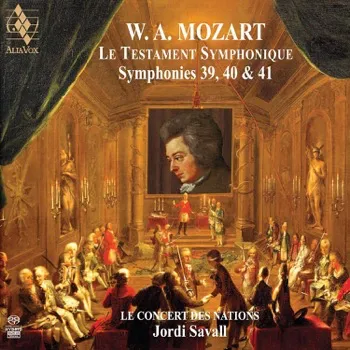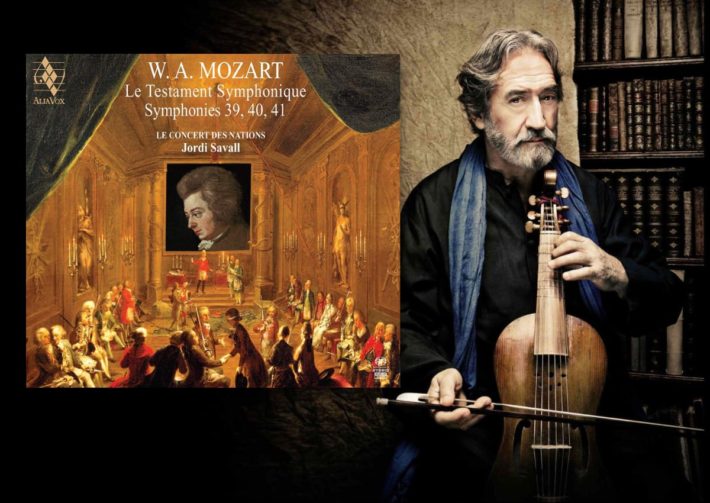These performances, titled “Le Testament Symphonique”, mark the return of Jordi Savall and his period group “Le Concert des Nations” to Mozart, after memorable versions of the composer’s Requiem and Serenades.

Savall’s Mozart, as well as his treatment of other composers from the 18th century, is very special indeed. Contrary to other period instrument groups, there is less cutting edge accuracy or volume enhancement by the producers, making the sound very similar to what one may experience sitting in a resonant hall, listening to a modestly sized period-instrument ensemble. Listeners who got used to the sharp, big and loud sound world may recoil, but as authenticity goes, this seems a much better representation of the performance practices of the time these Symphonies were composed (1788).
And so, the opening of the E Flat Major Symphony (K.543) is celebratory without being ponderous, and the slow movement of the same piece with its stormy episodes is conveyed directly, almost plainly, rather than outspoken, the last movement’s fast figurations by the strings are more atmospheric than literal.
The famous Symphony No. 40, (K.550) has a nice story-telling quality to it, with pregnant pauses and superb woodwind work, brought to the fore. The third movement, at last, is played as a Menuett and not hectically paced as in so many period instruments performances. It is preceded by a calming, inward-looking rendition of the slow movement, again in perfectly judged tempo for an Andante. And the final is full of vigor while keeping the same sanity preserved in this entire performance.
Form the three Symphonies, it is the “Jupiter” that may feel a little underwhelming here, guarding the modesty of the first two yet lacking in an additional dramatic effect. There are charming moments, such as the second subject of the first movement, or the account of the Andante, where Savall brings out the Haydn influence and is sensitive to the harmonic changes, where everything turns dark in a moment’s notice. But the Menuetto is a little too casual and the brilliant contrapuntal writing of the last movement could have benefited from additional clarity. Turn to Harnoncourt’s last effort of this Symphony and you’ll get a much more exciting alternative.
Like Harnoncourt, Savall sees the last three Symphonies as a cycle, to be listened to continuously. Harnoncourt was so convinced in this assessment, that he played the 3 consecutively in concert without a break. This release, spread into two hybrid SACDs, contains two identical versions of Symphony No. 40 on each CD, so listeners can have a chance at continuous listening. It’s a generous offering, but may feel as though sitting in a Michelin restaurant, with the chef insisting on the order of which you should eat your dishes.
The recording, like Savall’s several latest recordings, is made at “Collegiale de Cardona” (catalogne), a highly resonant venue that nonetheless suits the interpretation. Overall, this is a distinguished version of these masterpieces, that will demand some adjustment from listeners already familiar with these Symphonies or period instruments practices. Savall brings something unique to the catalog, and the chances are that during Mozart’s lifetime – with the little to no time to rehearse and the persistent problems of venues, instruments and available musicians – this sound-world makes for a much better assumption, if “authenticity” is of high concern.
Mozart – Symphonies No. 39 (K.543), No. 40 (K.550), No. 41 (“Jupiter”, K.551), Maurerische Trauermusik (K.477)
Le Concert des Nations
Jordi Savall – Conductor
ALIA VOX, SACD Hybrid AVSA 9934




















